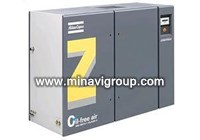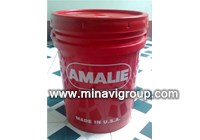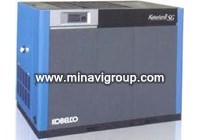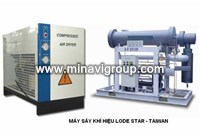NGUYÊN LÝ HOẠT ĐỘNG MÁY NÉN KHÍ
Thứ Ba, 02/04/2013
Nguyên lý hoạt động máy nén khí đã được đề cập trong các bài trước... Trong bài 3 chúng tôi sẽ viết về đề tài này "nặng" về kỹ thuật hơn với từng loại máy.
Nguyên lý
Khí nén được tạo ra từ máy nén khí, ở đó năng lượng cơ học của động cơ điện hoặc của động cơ đốt trong được chuyển đổi thành năng lượng khí nén và nhiệt năng. Máy nén khí được hoạt động theo hai nguyên lý sau:
- Nguyên lý thay đổi thể tích : Không khí được dẫn vào buồng chứa có thể tích nhỏ hơn. Như vậy theo định luật Boyle-Matiotte Áp suất trong buồng chứa sẽ tăng lên. Máy nén khí hoạt động theo nguyên lý này như kiểu máy nén khí piston, bánh răng, cánh gạt.
- Nguyên lý động năng: không khí được dẫn vào bình chứa sau khi được gia tốc bởi một bộ phận quay với tốc độ cao, Áp suất khí nén được tạo ra nhờ sự chênh lệch vận tốc, nguyên tắc này tạo ra lưu lượng và công suất rất lớn. Máy nén khí hoạt động theo nguyên lý này như máy nén khí ly tâm.

- Có nhiều loại máy nén khí khác nhau đang được sử dụng trong công nghiệp, từ đơn giản dùng trong viêc bơm xe đến các nhà máy trung bình và lớn dùng trong công nghiệp hầm mỏ và các xưởng sản xuất. Do đó tùy theo cách phân loại máy nén khí:
Máy nén khí áp suất thấp P <15bar
Máy nén khí áp suất cao P > 15bar
Máy nén khí áp suất cao P > 300bar
Máy nén khí trục vít áp suất 8bar
Máy nén khí trục vít không dầu áp suất 8bar
Máy nén khí trục vít hồi dầu 8bar
Máy nén khí piston thấp áp 8-15bar
Máy nén khí piston cao áp không dầu 15-35bar
Máy nén khí piston cao áp có dầu 15- 35bar
Nguyên lý hoạt động của từng loại máy nén khí
Máy nén khí kiểu piston:

Máy nén khí piston một cấp: Ở kì nạp, chân không được tạo lập phía trên piston, do đó không khí được đẩy vào buồng nén thông qua van nạp. Van này mở tự động do sự chênh lệch áp suất gây ra bởi chân không ở trên bề mặt piston. Khi piston đi xuống tới “ điểm chết dưới” và bắt đầu đi lên, không khí đi vào buồng nén do sự mất cân bằng áp suất phía trên và dưới nên van nạp đóng lại và quá trình nén khí bắt đầu xảy ra. Khi áp suất trong buồng nén tăng tới một mức nào đó sẽ làm cho van thoát mở ra, khí nén sẽ thoát qua van thoát để đi vào hệ thống khí nén.
* Cả hai van nạp và thoát thường có lò xo và các van đóng mở tự động do sự chênh lệch áp suất ở phía của mỗi van.
* Sau khi piston lên đến “điểm chết trên” và bắt đầu đi xuống trở lại, van thoát đóng và một chu trình nén khí mơi bắt đầu.
* Máy nén khí kiểu piston một cấp có thể hút được lượng đến 10m/phút và áp suất nén được 6 bar, có thể trong một số trường hợp áp suất nén đến 10 bar. Máy nén khí kiểu piston 2 cấp có thể nén đến áp suất 15 bar. Loại máy nén khí kiểu piston 3,4 cấp có thể nén áp suất đến 250 bar.
* Loại máy nén khí một cấp và hai cấp thích hợp hệ thống điều khiển bằng khí nén trong công nghiệp. Máy nén khí piston được phân loại theo số cấp nén, loại truyền động và phương thức làm nguội khí nén.
Máy nén khí kiểu trục vít:

* Máy nén khi trục vít hoạt động theo nguyên lý thay đổi thể tích. Máy nén khí trục vít gồm có hai trục. Trục chính và trục phụ.
* Máy nén khí trục vít xuất hiện vào thập niên 50 và đã chiếm một thị phần lớn trong lãnh vực khí nén, Loại máy nén khí này có vỏ đặt biệt bao bọc quanh hai trục vít quay, 1 lồi một lõm. Các răng của hai trục vít ăn khớp với nhau và số răng trục vít lồi ít hơn trục vít lõm 1 đến 2 răng. Hai trục vít phải quay đồng bộ với nhau, giữa các trục vít và vỏ bọc có khe hở rất nhỏ.
* Khi các trục vít quay nhanh, không khí được hút vào bên trong vỏ thông qua cửa nạp và đi vào buồng khí ở giữa các trục vít và ở đó không khí được nén giữa các răng khi buồng khí nhỏ lại, sau đó khí nén đi tới cửa thoát. Cả cửa nạp và cửa thoát sẽ được đóng hoặc mở tự động khi các trục vít quay , Ở cửa thoát của máy nén khí có lắp một van một chiều để ngăn các trục vít tự quay khi quá trình nén đã ngừng.
* Máy nén khí trục vít có nhiều tính chất giống với máy nén khí cánh gạt, chẳng hạn như sự ổn định và không dao động trong khí thoát, ít rung động và tiếng ồn nhỏ. Đạt hiệu suất cao nhất khi hoạt động gần đầy tải.
* Lưu lượng từ 1,4m/phút và có thể lên đến 60m/phút,
Máy nén khí li tâm:
- Trong máy nén khí li tâm, mỗi cấp gồm một ngăn, một cánh quạt, một bộ khuếch tán và một ống khuếch tán tổ hợp. Khi cánh quạt quay có nhiều cánh với tốc độ cao, không khí được hút vào giữa cánh quạt với vận tốc lớn và áp suất cao sao đó không khí đi vào vòng khuếch tán tĩnh, ở đó không khí giản nở vì vậy vận tốc của nó giảm nhưng áp suất tăng một cách đáng kể. Từ bộ khuếch tán tổ hợp không khí giản nở thêm và áp suất tăng rồi đi đến cấp kế tiếp hoặc trực tiếp đến ngõ ra. Không giống như loại máy nén khí hướng trục, việc chia cấp cúa máy nén khi này rất đơn giản.
Đọc thêm bài viết tiếng anh:
Types of compressors
The main types of gas compressors are illustrated and discussed below:

Centrifugal Compressors
Centrifugal compressors use the rotating action of an impeller wheel to exert centrifugal force on refrigerant inside a round chamber (volute). Refrigerant is sucked into the impeller wheel through a large circular intake and flows between the impellers. The impellers force the refrigerant outward, exerting centrifugal force on the refrigerant. The refrigerant is pressurized as it is forced against the sides of the volute. Centrifugal compressors are well suited to compressing large volumes of refrigerant to relatively low pressures. The compressive force generated by an impeller wheel is small, so chillers that use centrifugal compressors usually employ more than one impeller wheel, arranged in series. Centrifugal compressors are desirable for their simple design and few moving parts.

Diagonal or mixed-flow compressors
Diagonal or mixed-flow compressors are similar to centrifugal compressors, but have a radial and axial velocity component at the exit from the rotor. The diffuser is often used to turn diagonal flow to the axial direction. The diagonal compressor has a lower diameter diffuser than the equivalent centrifugal compressor.
Axial-flow compressors
Axial-flow compressors are dynamic rotating compressors that use arrays of fan-like aerofoils to progressively compress the working fluid. They are used where there is a requirement for a high flows or a compact design.The arrays of aerofoils are set in rows, usually as pairs: one rotating and one stationary. The rotating aerofoils, also known as blades or rotors, decelerate and pressurise the fluid. The stationary aerofoils, also known as a stators or vanes, turn and decelerate the fluid; preparing and redirecting the flow for the rotor blades of the next stage. Axial compressors are almost always multi-staged, with the cross-sectional area of the gas passage diminishing along the compressor to maintain an optimum axial Mach number. Beyond about 5 stages or a 4:1 design pressure ratio, variable geometry is normally used to improve operation. Axial compressors can have high efficiencies; around 90% polytropic at their design conditions. However, they are relatively expensive, requiring a large number of components, tight tolerances and high quality materials. Axial-flow compressors can be found in medium to large gas turbine engines, in natural gas pumping stations, and within certain chemical plants.


Reciprocating Compressors
A reciprocating compressor uses the reciprocating action of a piston inside a cylinder to compress refrigerant. As the piston moves downward, a vacuum is created inside the cylinder. Because the pressure above the intake valve is greater than the pressure below it, the intake valve is forced open and refrigerant is sucked into the cylinder. After the piston reaches its bottom position it begins to move upward. The intake valve closes, trapping the refrigerant inside the cylinder. As the piston continues to move upward it compresses the refrigerant, increasing its pressure. At a certain point the pressure exerted by the refrigerant forces the exhaust valve to open and the compressed refrigerant flows out of the cylinder. Once the piston reaches it top-most position, it starts moving downward again and the cycle is repeated.

Rotary Compressors
In a rotary compressor the refrigerant is compressed by the rotating action of a roller inside a cylinder. The roller rotates eccentrically (off-centre) around a shaft so that part of the roller is always in contact with the inside wall of the cylinder. A spring-mounted blade is always rubbing against the roller. The two points of contact create two sealed areas of continuously variable volume inside the cylinder. At a certain point in the rotation of the roller, the intake port is exposed and a quantity of refrigerant is sucked into the cylinder, filling one of the sealed areas. As the roller continues to rotate the volume of the area the refrigerant occupies is reduced and the refrigerant is compressed. When the exhaust valve is exposed, the high-pressure refrigerant forces the exhaust valve to open and the refrigerant is released. Rotary compressors are very efficient because the actions of taking in refrigerant and compressing refrigerant occur simultaneously.

Diaphragm compressor
A diaphragm compressor (also known as a membrane compressor) is a variant of the conventional reciprocating compressor. The compression of gas occurs by the movement of a flexible membrane, instead of an intake element. The back and forth movement of the membrane is driven by a rod and a crankshaft mechanism. Only the membrane and the compressor box come in touch with the gas being compressed. Diaphragm compressors are used for hydrogen and compressed natural gas (CNG) as well as in a number of other applications.
Rotary Scroll Compressors
In a scroll compressor refrigerant is compressed by two offset spiral disks that are nested together. The upper disk is stationary while the lower disk moves in orbital fashion. The orbiting action of the lower disk inside the stationary disk creates sealed spaces of varying volume. Refrigerant is sucked in through inlet ports at the perimeter of the scroll. A quantity of refrigerant becomes trapped in one of the sealed spaces. As the disk orbits the enclosed space containing the refrigerant is transferred toward the centre of the disk and its volume decreases. As the volume decreases, the refrigerant is compressed. The compressed refrigerant is discharged through a port at the centre of the upper disk. Scroll compressors are quiet, smooth-operating units with the highest efficiency ratio of all compressor types. They are commonly used in automobile air conditioning systems and commercial chillers.

Rotary Screw Compressors
Screw compressors use a pair of helical rotorsAs the rotors rotate they intermesh, alternately exposing and closing off interlobe spaces at the ends of the rotors. When an interlobe space at the intake end opens up, refrigerant is sucked into it. As the rotors continue to rotate the refrigerant becomes trapped inside the interlobe space and is forced along the length of the rotors. The volume of the interlobe space decreases and the refrigerant is compressed. The compressed refrigerant exists when the interlobe space reaches the other end. (male and female) inside a sealed chamber.



Rotary vane compressors
Rotary vane compressors consist of a rotor with a number of blades inserted in radial slots in the rotor. The rotor is mounted offset in a larger housing which can be circular or a more complex shape. As the rotor turns, blades slide in and out of the slots keeping contact with the outer wall of the housing.Thus, a series of decreasing volumes is created by the rotating blades. Rotary Vane compressors are, with piston compressors one of the oldest of compressor technologies. With suitable port connections, the devices may be either a compressor or a vacuum pump. They can be either stationary or portable, can be single or multi-staged, and can be driven by electric motors or internal combustion engines. Dry vane machines are used at relatively low pressures (e.g., 2 bar) for bulk material movement whilst oil-injected machines have the necessary volumetric efficiency to achieve pressures up to about 13 bar in a single stage. A rotary vane compressor is well suited to electric motor drive and is significantly quieter in operation than the equivalent piston compressor.
Nguyên lý
Khí nén được tạo ra từ máy nén khí, ở đó năng lượng cơ học của động cơ điện hoặc của động cơ đốt trong được chuyển đổi thành năng lượng khí nén và nhiệt năng. Máy nén khí được hoạt động theo hai nguyên lý sau:
- Nguyên lý thay đổi thể tích : Không khí được dẫn vào buồng chứa có thể tích nhỏ hơn. Như vậy theo định luật Boyle-Matiotte Áp suất trong buồng chứa sẽ tăng lên. Máy nén khí hoạt động theo nguyên lý này như kiểu máy nén khí piston, bánh răng, cánh gạt.
- Nguyên lý động năng: không khí được dẫn vào bình chứa sau khi được gia tốc bởi một bộ phận quay với tốc độ cao, Áp suất khí nén được tạo ra nhờ sự chênh lệch vận tốc, nguyên tắc này tạo ra lưu lượng và công suất rất lớn. Máy nén khí hoạt động theo nguyên lý này như máy nén khí ly tâm.

- Có nhiều loại máy nén khí khác nhau đang được sử dụng trong công nghiệp, từ đơn giản dùng trong viêc bơm xe đến các nhà máy trung bình và lớn dùng trong công nghiệp hầm mỏ và các xưởng sản xuất. Do đó tùy theo cách phân loại máy nén khí:
Máy nén khí áp suất thấp P <15bar
Máy nén khí áp suất cao P > 15bar
Máy nén khí áp suất cao P > 300bar
Máy nén khí trục vít áp suất 8bar
Máy nén khí trục vít không dầu áp suất 8bar
Máy nén khí trục vít hồi dầu 8bar
Máy nén khí piston thấp áp 8-15bar
Máy nén khí piston cao áp không dầu 15-35bar
Máy nén khí piston cao áp có dầu 15- 35bar
Nguyên lý hoạt động của từng loại máy nén khí
Máy nén khí kiểu piston:

Máy nén khí piston một cấp: Ở kì nạp, chân không được tạo lập phía trên piston, do đó không khí được đẩy vào buồng nén thông qua van nạp. Van này mở tự động do sự chênh lệch áp suất gây ra bởi chân không ở trên bề mặt piston. Khi piston đi xuống tới “ điểm chết dưới” và bắt đầu đi lên, không khí đi vào buồng nén do sự mất cân bằng áp suất phía trên và dưới nên van nạp đóng lại và quá trình nén khí bắt đầu xảy ra. Khi áp suất trong buồng nén tăng tới một mức nào đó sẽ làm cho van thoát mở ra, khí nén sẽ thoát qua van thoát để đi vào hệ thống khí nén.
* Cả hai van nạp và thoát thường có lò xo và các van đóng mở tự động do sự chênh lệch áp suất ở phía của mỗi van.
* Sau khi piston lên đến “điểm chết trên” và bắt đầu đi xuống trở lại, van thoát đóng và một chu trình nén khí mơi bắt đầu.
* Máy nén khí kiểu piston một cấp có thể hút được lượng đến 10m/phút và áp suất nén được 6 bar, có thể trong một số trường hợp áp suất nén đến 10 bar. Máy nén khí kiểu piston 2 cấp có thể nén đến áp suất 15 bar. Loại máy nén khí kiểu piston 3,4 cấp có thể nén áp suất đến 250 bar.
* Loại máy nén khí một cấp và hai cấp thích hợp hệ thống điều khiển bằng khí nén trong công nghiệp. Máy nén khí piston được phân loại theo số cấp nén, loại truyền động và phương thức làm nguội khí nén.
Máy nén khí kiểu trục vít:

* Máy nén khi trục vít hoạt động theo nguyên lý thay đổi thể tích. Máy nén khí trục vít gồm có hai trục. Trục chính và trục phụ.
* Máy nén khí trục vít xuất hiện vào thập niên 50 và đã chiếm một thị phần lớn trong lãnh vực khí nén, Loại máy nén khí này có vỏ đặt biệt bao bọc quanh hai trục vít quay, 1 lồi một lõm. Các răng của hai trục vít ăn khớp với nhau và số răng trục vít lồi ít hơn trục vít lõm 1 đến 2 răng. Hai trục vít phải quay đồng bộ với nhau, giữa các trục vít và vỏ bọc có khe hở rất nhỏ.
* Khi các trục vít quay nhanh, không khí được hút vào bên trong vỏ thông qua cửa nạp và đi vào buồng khí ở giữa các trục vít và ở đó không khí được nén giữa các răng khi buồng khí nhỏ lại, sau đó khí nén đi tới cửa thoát. Cả cửa nạp và cửa thoát sẽ được đóng hoặc mở tự động khi các trục vít quay , Ở cửa thoát của máy nén khí có lắp một van một chiều để ngăn các trục vít tự quay khi quá trình nén đã ngừng.
* Máy nén khí trục vít có nhiều tính chất giống với máy nén khí cánh gạt, chẳng hạn như sự ổn định và không dao động trong khí thoát, ít rung động và tiếng ồn nhỏ. Đạt hiệu suất cao nhất khi hoạt động gần đầy tải.
* Lưu lượng từ 1,4m/phút và có thể lên đến 60m/phút,
Máy nén khí li tâm:
- Trong máy nén khí li tâm, mỗi cấp gồm một ngăn, một cánh quạt, một bộ khuếch tán và một ống khuếch tán tổ hợp. Khi cánh quạt quay có nhiều cánh với tốc độ cao, không khí được hút vào giữa cánh quạt với vận tốc lớn và áp suất cao sao đó không khí đi vào vòng khuếch tán tĩnh, ở đó không khí giản nở vì vậy vận tốc của nó giảm nhưng áp suất tăng một cách đáng kể. Từ bộ khuếch tán tổ hợp không khí giản nở thêm và áp suất tăng rồi đi đến cấp kế tiếp hoặc trực tiếp đến ngõ ra. Không giống như loại máy nén khí hướng trục, việc chia cấp cúa máy nén khi này rất đơn giản.
Đọc thêm bài viết tiếng anh:
Types of compressors
The main types of gas compressors are illustrated and discussed below:

Centrifugal Compressors
Centrifugal compressors use the rotating action of an impeller wheel to exert centrifugal force on refrigerant inside a round chamber (volute). Refrigerant is sucked into the impeller wheel through a large circular intake and flows between the impellers. The impellers force the refrigerant outward, exerting centrifugal force on the refrigerant. The refrigerant is pressurized as it is forced against the sides of the volute. Centrifugal compressors are well suited to compressing large volumes of refrigerant to relatively low pressures. The compressive force generated by an impeller wheel is small, so chillers that use centrifugal compressors usually employ more than one impeller wheel, arranged in series. Centrifugal compressors are desirable for their simple design and few moving parts.

Diagonal or mixed-flow compressors
Diagonal or mixed-flow compressors are similar to centrifugal compressors, but have a radial and axial velocity component at the exit from the rotor. The diffuser is often used to turn diagonal flow to the axial direction. The diagonal compressor has a lower diameter diffuser than the equivalent centrifugal compressor.
Axial-flow compressors
Axial-flow compressors are dynamic rotating compressors that use arrays of fan-like aerofoils to progressively compress the working fluid. They are used where there is a requirement for a high flows or a compact design.The arrays of aerofoils are set in rows, usually as pairs: one rotating and one stationary. The rotating aerofoils, also known as blades or rotors, decelerate and pressurise the fluid. The stationary aerofoils, also known as a stators or vanes, turn and decelerate the fluid; preparing and redirecting the flow for the rotor blades of the next stage. Axial compressors are almost always multi-staged, with the cross-sectional area of the gas passage diminishing along the compressor to maintain an optimum axial Mach number. Beyond about 5 stages or a 4:1 design pressure ratio, variable geometry is normally used to improve operation. Axial compressors can have high efficiencies; around 90% polytropic at their design conditions. However, they are relatively expensive, requiring a large number of components, tight tolerances and high quality materials. Axial-flow compressors can be found in medium to large gas turbine engines, in natural gas pumping stations, and within certain chemical plants.


Reciprocating Compressors
A reciprocating compressor uses the reciprocating action of a piston inside a cylinder to compress refrigerant. As the piston moves downward, a vacuum is created inside the cylinder. Because the pressure above the intake valve is greater than the pressure below it, the intake valve is forced open and refrigerant is sucked into the cylinder. After the piston reaches its bottom position it begins to move upward. The intake valve closes, trapping the refrigerant inside the cylinder. As the piston continues to move upward it compresses the refrigerant, increasing its pressure. At a certain point the pressure exerted by the refrigerant forces the exhaust valve to open and the compressed refrigerant flows out of the cylinder. Once the piston reaches it top-most position, it starts moving downward again and the cycle is repeated.

Rotary Compressors
In a rotary compressor the refrigerant is compressed by the rotating action of a roller inside a cylinder. The roller rotates eccentrically (off-centre) around a shaft so that part of the roller is always in contact with the inside wall of the cylinder. A spring-mounted blade is always rubbing against the roller. The two points of contact create two sealed areas of continuously variable volume inside the cylinder. At a certain point in the rotation of the roller, the intake port is exposed and a quantity of refrigerant is sucked into the cylinder, filling one of the sealed areas. As the roller continues to rotate the volume of the area the refrigerant occupies is reduced and the refrigerant is compressed. When the exhaust valve is exposed, the high-pressure refrigerant forces the exhaust valve to open and the refrigerant is released. Rotary compressors are very efficient because the actions of taking in refrigerant and compressing refrigerant occur simultaneously.

Diaphragm compressor
A diaphragm compressor (also known as a membrane compressor) is a variant of the conventional reciprocating compressor. The compression of gas occurs by the movement of a flexible membrane, instead of an intake element. The back and forth movement of the membrane is driven by a rod and a crankshaft mechanism. Only the membrane and the compressor box come in touch with the gas being compressed. Diaphragm compressors are used for hydrogen and compressed natural gas (CNG) as well as in a number of other applications.
Rotary Scroll Compressors
In a scroll compressor refrigerant is compressed by two offset spiral disks that are nested together. The upper disk is stationary while the lower disk moves in orbital fashion. The orbiting action of the lower disk inside the stationary disk creates sealed spaces of varying volume. Refrigerant is sucked in through inlet ports at the perimeter of the scroll. A quantity of refrigerant becomes trapped in one of the sealed spaces. As the disk orbits the enclosed space containing the refrigerant is transferred toward the centre of the disk and its volume decreases. As the volume decreases, the refrigerant is compressed. The compressed refrigerant is discharged through a port at the centre of the upper disk. Scroll compressors are quiet, smooth-operating units with the highest efficiency ratio of all compressor types. They are commonly used in automobile air conditioning systems and commercial chillers.

Rotary Screw Compressors
Screw compressors use a pair of helical rotorsAs the rotors rotate they intermesh, alternately exposing and closing off interlobe spaces at the ends of the rotors. When an interlobe space at the intake end opens up, refrigerant is sucked into it. As the rotors continue to rotate the refrigerant becomes trapped inside the interlobe space and is forced along the length of the rotors. The volume of the interlobe space decreases and the refrigerant is compressed. The compressed refrigerant exists when the interlobe space reaches the other end. (male and female) inside a sealed chamber.



Rotary vane compressors
Rotary vane compressors consist of a rotor with a number of blades inserted in radial slots in the rotor. The rotor is mounted offset in a larger housing which can be circular or a more complex shape. As the rotor turns, blades slide in and out of the slots keeping contact with the outer wall of the housing.Thus, a series of decreasing volumes is created by the rotating blades. Rotary Vane compressors are, with piston compressors one of the oldest of compressor technologies. With suitable port connections, the devices may be either a compressor or a vacuum pump. They can be either stationary or portable, can be single or multi-staged, and can be driven by electric motors or internal combustion engines. Dry vane machines are used at relatively low pressures (e.g., 2 bar) for bulk material movement whilst oil-injected machines have the necessary volumetric efficiency to achieve pressures up to about 13 bar in a single stage. A rotary vane compressor is well suited to electric motor drive and is significantly quieter in operation than the equivalent piston compressor.






